Alex Wong
Extending Foundational Monocular Depth Estimators to Fisheye Cameras with Calibration Tokens
Aug 06, 2025Abstract:We propose a method to extend foundational monocular depth estimators (FMDEs), trained on perspective images, to fisheye images. Despite being trained on tens of millions of images, FMDEs are susceptible to the covariate shift introduced by changes in camera calibration (intrinsic, distortion) parameters, leading to erroneous depth estimates. Our method aligns the distribution of latent embeddings encoding fisheye images to those of perspective images, enabling the reuse of FMDEs for fisheye cameras without retraining or finetuning. To this end, we introduce a set of Calibration Tokens as a light-weight adaptation mechanism that modulates the latent embeddings for alignment. By exploiting the already expressive latent space of FMDEs, we posit that modulating their embeddings avoids the negative impact of artifacts and loss introduced in conventional recalibration or map projection to a canonical reference frame in the image space. Our method is self-supervised and does not require fisheye images but leverages publicly available large-scale perspective image datasets. This is done by recalibrating perspective images to fisheye images, and enforcing consistency between their estimates during training. We evaluate our approach with several FMDEs, on both indoors and outdoors, where we consistently improve over state-of-the-art methods using a single set of tokens for both. Code available at: https://github.com/JungHeeKim29/calibration-token.
ODE-GS: Latent ODEs for Dynamic Scene Extrapolation with 3D Gaussian Splatting
Jun 05, 2025Abstract:We present ODE-GS, a novel method that unifies 3D Gaussian Splatting with latent neural ordinary differential equations (ODEs) to forecast dynamic 3D scenes far beyond the time span seen during training. Existing neural rendering systems - whether NeRF- or 3DGS-based - embed time directly in a deformation network and therefore excel at interpolation but collapse when asked to predict the future, where timestamps are strictly out-of-distribution. ODE-GS eliminates this dependency: after learning a high-fidelity, time-conditioned deformation model for the training window, we freeze it and train a Transformer encoder that summarizes past Gaussian trajectories into a latent state whose continuous evolution is governed by a neural ODE. Numerical integration of this latent flow yields smooth, physically plausible Gaussian trajectories that can be queried at any future instant and rendered in real time. Coupled with a variational objective and a lightweight second-derivative regularizer, ODE-GS attains state-of-the-art extrapolation on D-NeRF and NVFI benchmarks, improving PSNR by up to 10 dB and halving perceptual error (LPIPS) relative to the strongest baselines. Our results demonstrate that continuous-time latent dynamics are a powerful, practical route to photorealistic prediction of complex 3D scenes.
STree: Speculative Tree Decoding for Hybrid State-Space Models
May 20, 2025Abstract:Speculative decoding is a technique to leverage hardware concurrency to improve the efficiency of large-scale autoregressive (AR) Transformer models by enabling multiple steps of token generation in a single forward pass. State-space models (SSMs) are already more efficient than AR Transformers, since their state summarizes all past data with no need to cache or re-process tokens in the sliding window context. However, their state can also comprise thousands of tokens; so, speculative decoding has recently been extended to SSMs. Existing approaches, however, do not leverage the tree-based verification methods, since current SSMs lack the means to compute a token tree efficiently. We propose the first scalable algorithm to perform tree-based speculative decoding in state-space models (SSMs) and hybrid architectures of SSMs and Transformer layers. We exploit the structure of accumulated state transition matrices to facilitate tree-based speculative decoding with minimal overhead to current SSM state update implementations. With the algorithm, we describe a hardware-aware implementation that improves naive application of AR Transformer tree-based speculative decoding methods to SSMs. Furthermore, we outperform vanilla speculative decoding with SSMs even with a baseline drafting model and tree structure on three different benchmarks, opening up opportunities for further speed up with SSM and hybrid model inference. Code will be released upon paper acceptance.
Radar-Guided Polynomial Fitting for Metric Depth Estimation
Mar 21, 2025



Abstract:We propose PolyRad, a novel radar-guided depth estimation method that introduces polynomial fitting to transform scaleless depth predictions from pretrained monocular depth estimation (MDE) models into metric depth maps. Unlike existing approaches that rely on complex architectures or expensive sensors, our method is grounded in a simple yet fundamental insight: using polynomial coefficients predicted from cheap, ubiquitous radar data to adaptively adjust depth predictions non-uniformly across depth ranges. Although MDE models often infer reasonably accurate local depth structure within each object or local region, they may misalign these regions relative to one another, making a linear scale-and-shift transformation insufficient given three or more of these regions. In contrast, PolyRad generalizes beyond linear transformations and is able to correct such misalignments by introducing inflection points. Importantly, our polynomial fitting framework preserves structural consistency through a novel training objective that enforces monotonicity via first-derivative regularization. PolyRad achieves state-of-the-art performance on the nuScenes, ZJU-4DRadarCam, and View-of-Delft datasets, outperforming existing methods by 30.3% in MAE and 37.2% in RMSE.
Progressive Test Time Energy Adaptation for Medical Image Segmentation
Mar 20, 2025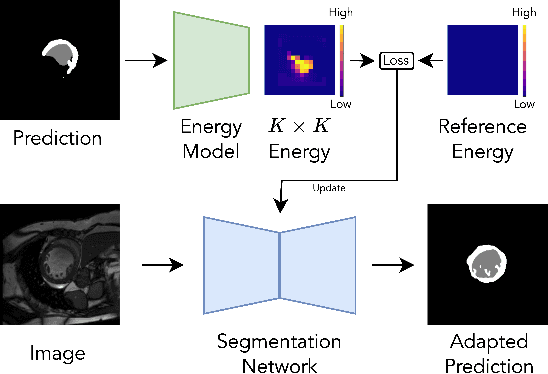
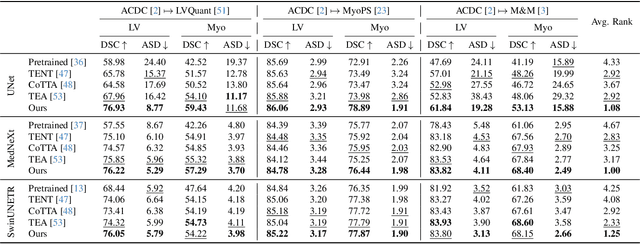
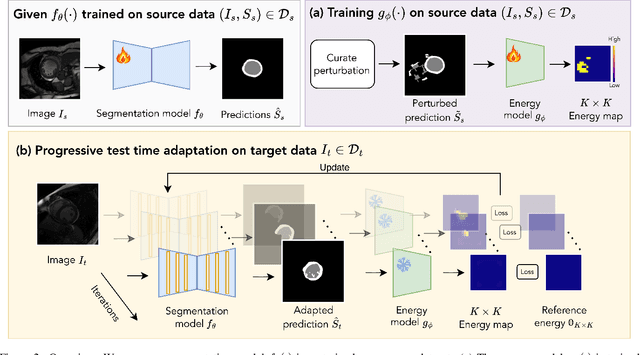
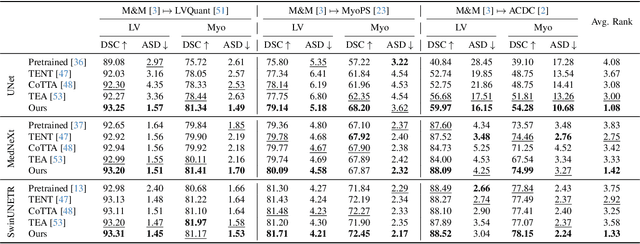
Abstract:We propose a model-agnostic, progressive test-time energy adaptation approach for medical image segmentation. Maintaining model performance across diverse medical datasets is challenging, as distribution shifts arise from inconsistent imaging protocols and patient variations. Unlike domain adaptation methods that require multiple passes through target data - impractical in clinical settings - our approach adapts pretrained models progressively as they process test data. Our method leverages a shape energy model trained on source data, which assigns an energy score at the patch level to segmentation maps: low energy represents in-distribution (accurate) shapes, while high energy signals out-of-distribution (erroneous) predictions. By minimizing this energy score at test time, we refine the segmentation model to align with the target distribution. To validate the effectiveness and adaptability, we evaluated our framework on eight public MRI (bSSFP, T1- and T2-weighted) and X-ray datasets spanning cardiac, spinal cord, and lung segmentation. We consistently outperform baselines both quantitatively and qualitatively.
ProtoDepth: Unsupervised Continual Depth Completion with Prototypes
Mar 17, 2025



Abstract:We present ProtoDepth, a novel prototype-based approach for continual learning of unsupervised depth completion, the multimodal 3D reconstruction task of predicting dense depth maps from RGB images and sparse point clouds. The unsupervised learning paradigm is well-suited for continual learning, as ground truth is not needed. However, when training on new non-stationary distributions, depth completion models will catastrophically forget previously learned information. We address forgetting by learning prototype sets that adapt the latent features of a frozen pretrained model to new domains. Since the original weights are not modified, ProtoDepth does not forget when test-time domain identity is known. To extend ProtoDepth to the challenging setting where the test-time domain identity is withheld, we propose to learn domain descriptors that enable the model to select the appropriate prototype set for inference. We evaluate ProtoDepth on benchmark dataset sequences, where we reduce forgetting compared to baselines by 52.2% for indoor and 53.2% for outdoor to achieve the state of the art.
Efficient Interactive 3D Multi-Object Removal
Jan 30, 2025Abstract:Object removal is of great significance to 3D scene understanding, essential for applications in content filtering and scene editing. Current mainstream methods primarily focus on removing individual objects, with a few methods dedicated to eliminating an entire area or all objects of a certain category. They however confront the challenge of insufficient granularity and flexibility for real-world applications, where users demand tailored excision and preservation of objects within defined zones. In addition, most of the current methods require kinds of priors when addressing multi-view inpainting, which is time-consuming. To address these limitations, we propose an efficient and user-friendly pipeline for 3D multi-object removal, enabling users to flexibly select areas and define objects for removal or preservation. Concretely, to ensure object consistency and correspondence across multiple views, we propose a novel mask matching and refinement module, which integrates homography-based warping with high-confidence anchor points for segmentation. By leveraging the IoU joint shape context distance loss, we enhance the accuracy of warped masks and improve subsequent inpainting processes. Considering the current immaturity of 3D multi-object removal, we provide a new evaluation dataset to bridge the developmental void. Experimental results demonstrate that our method significantly reduces computational costs, achieving processing speeds more than 80% faster than state-of-the-art methods while maintaining equivalent or higher reconstruction quality.
CLAP: Unsupervised 3D Representation Learning for Fusion 3D Perception via Curvature Sampling and Prototype Learning
Dec 04, 2024



Abstract:Unsupervised 3D representation learning via masked-and-reconstruction with differentiable rendering is promising to reduce the labeling burden for fusion 3D perception. However, previous literature conduct pre-training for different modalities separately because of the hight GPU memory consumption. Consequently, the interaction between the two modalities (images and point clouds) is neglected during pre-training. In this paper, we explore joint unsupervised pre-training for fusion 3D perception via differentiable rendering and propose CLAP, short for Curvature sampLing and swApping Prototype assignment prediction. The contributions are three-fold. 1) To overcome the GPU memory consumption problem, we propose Curvature Sampling to sample the more informative points/pixels for pre-training. 2) We propose to use learnable prototypes to represent parts of the scenes in a common feature space and bring the idea of swapping prototype assignment prediction to learn the interaction between the two modalities. 3) To further optimize learnable prototypes, we propose an Expectation-Maximization training scheme to maximize the similarity between embeddings and prototypes, followed by a Gram Matrix Regularization Loss to avoid collapse. Experiment results on NuScenes show that CLAP achieves 300% more performance gain as compared to previous SOTA 3D pre-training method via differentiable rendering. Codes and models will be released.
TREND: Unsupervised 3D Representation Learning via Temporal Forecasting for LiDAR Perception
Dec 04, 2024



Abstract:Labeling LiDAR point clouds is notoriously time-and-energy-consuming, which spurs recent unsupervised 3D representation learning methods to alleviate the labeling burden in LiDAR perception via pretrained weights. Almost all existing work focus on a single frame of LiDAR point cloud and neglect the temporal LiDAR sequence, which naturally accounts for object motion (and their semantics). Instead, we propose TREND, namely Temporal REndering with Neural fielD, to learn 3D representation via forecasting the future observation in an unsupervised manner. Unlike existing work that follows conventional contrastive learning or masked auto encoding paradigms, TREND integrates forecasting for 3D pre-training through a Recurrent Embedding scheme to generate 3D embedding across time and a Temporal Neural Field to represent the 3D scene, through which we compute the loss using differentiable rendering. To our best knowledge, TREND is the first work on temporal forecasting for unsupervised 3D representation learning. We evaluate TREND on downstream 3D object detection tasks on popular datasets, including NuScenes, Once and Waymo. Experiment results show that TREND brings up to 90% more improvement as compared to previous SOTA unsupervised 3D pre-training methods and generally improve different downstream models across datasets, demonstrating that indeed temporal forecasting brings improvement for LiDAR perception. Codes and models will be released.
PriorDiffusion: Leverage Language Prior in Diffusion Models for Monocular Depth Estimation
Nov 24, 2024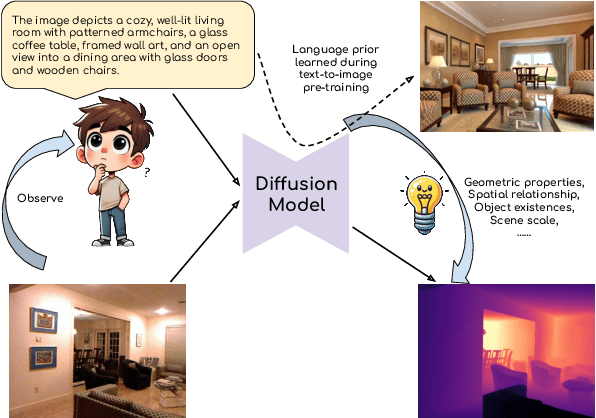
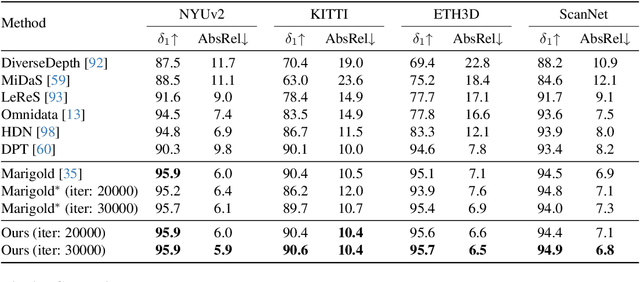
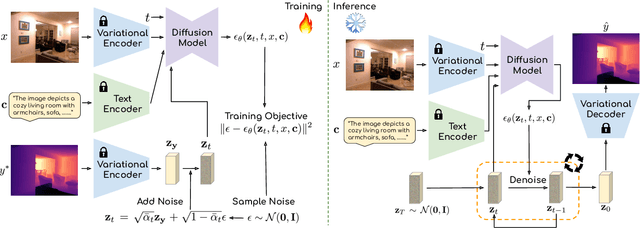
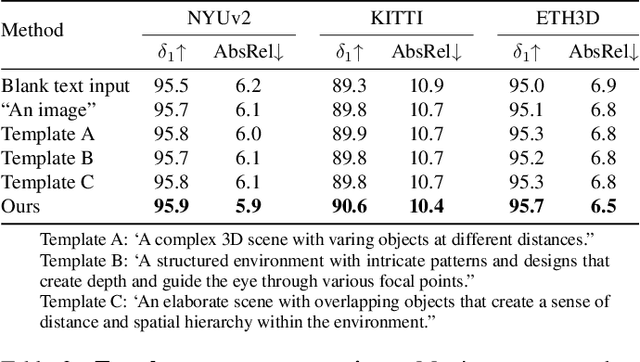
Abstract:This paper explores the potential of leveraging language priors learned by text-to-image diffusion models to address ambiguity and visual nuisance in monocular depth estimation. Particularly, traditional monocular depth estimation suffers from inherent ambiguity due to the absence of stereo or multi-view depth cues, and nuisance due to lack of robustness of vision. We argue that language prior in diffusion models can enhance monocular depth estimation by leveraging the geometric prior aligned with the language description, which is learned during text-to-image pre-training. To generate images that reflect the text properly, the model must comprehend the size and shape of specified objects, their spatial relationship, and the scale of the scene. Thus, we propose PriorDiffusion, using a pre-trained text-to-image diffusion model that takes both image and text description that aligned with the scene to infer affine-invariant depth through a denoising process. We also show that language priors can guide the model's attention to specific regions and help it perceive the 3D scene in alignment with user intent. Simultaneously, it acts as a constraint to accelerate the convergence of the diffusion trajectory, since learning 3D properties from a condensed, low-dimensional language feature is more efficient compared with learning from a redundant, high-dimensional image feature. By training on HyperSim and Virtual KITTI, we achieve state-of-the-art zero-shot performance and a faster convergence speed, compared with other diffusion-based depth estimators, across NYUv2, KITTI, ETH3D, and ScanNet.
 Add to Chrome
Add to Chrome Add to Firefox
Add to Firefox Add to Edge
Add to Edge